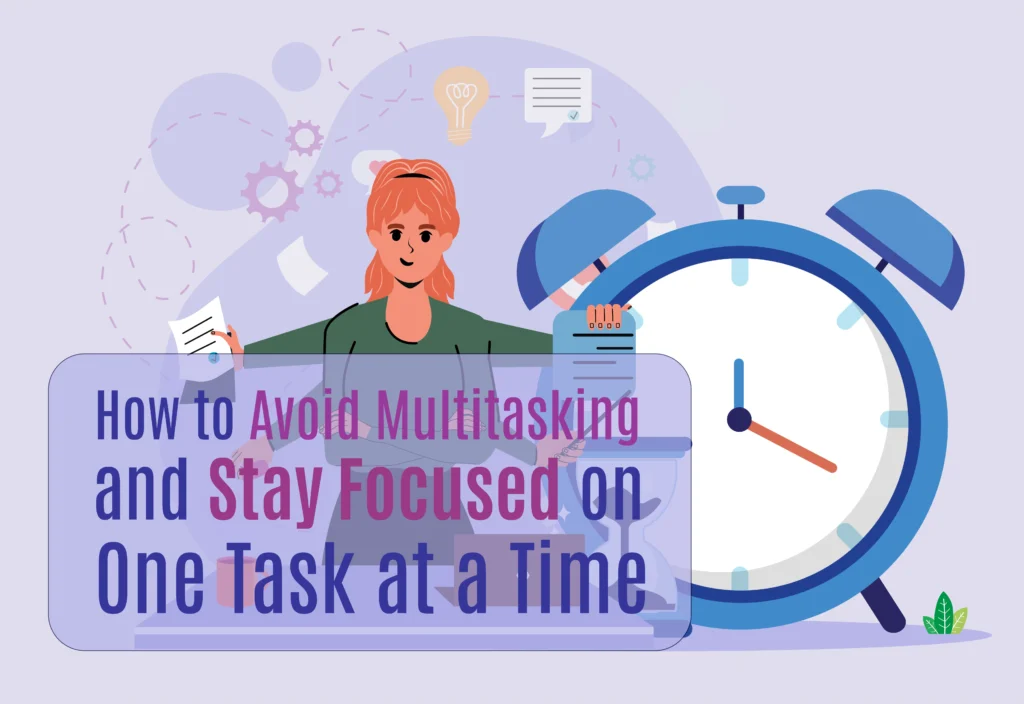How to Develop a Proactive Mindset and Avoid Procrastination
Procrastination is a challenge we all face from time to time. It can stem from many different factors—distraction, overwhelm, fear of failure, or simply not knowing where to start. However, one of the most effective ways to break the cycle of procrastination is by adopting a proactive mindset. Rather than waiting for external circumstances to dictate your actions, a proactive mindset allows you to take initiative, anticipate challenges, and stay focused on progress. It helps you gain control over your time and productivity, ultimately reducing procrastination.
In this blog post, we’ll explore the difference between reactive and proactive mindsets, how a reactive mindset leads to procrastination, and actionable strategies for developing a proactive mindset to get more done and achieve your goals.

Understanding the Reactive vs. Proactive Mindset
Before diving into how to develop a proactive mindset, it’s important to understand the key differences between a reactive mindset and a proactive mindset. These two ways of thinking influence how we approach our tasks and goals, and one tends to foster procrastination more than the other.
Characteristics of a Reactive Mindset
A reactive mindset is one where people tend to respond to events, circumstances, or other people’s actions rather than taking initiative. Individuals with a reactive mindset often:
- Wait for problems to arise before taking action.
- Feel overwhelmed or paralyzed by decisions.
- Allow external circumstances or others to dictate their priorities.
- Focus on short-term reactions rather than long-term goals.
- Tend to procrastinate because they feel they need more information or clarity before acting.
For example, a reactive person might delay starting a project because they’re waiting for feedback from a colleague or hoping for perfect conditions. This mindset leads to procrastination because it places control outside of the individual’s own hands, resulting in delayed action and lost opportunities.
Traits of a Proactive Mindset
On the other hand, a proactive mindset is characterized by taking initiative and anticipating challenges. Individuals with a proactive mindset:
- Take ownership of their actions and decisions.
- Anticipate potential obstacles and plan ahead.
- Focus on long-term outcomes and take consistent steps toward their goals.
- Prioritize tasks based on their own values and objectives, rather than external pressures.
- Tend to avoid procrastination because they are focused on solutions rather than problems.
A proactive person doesn’t wait for perfect conditions or external validation to take action. Instead, they break tasks into manageable steps, prioritize their responsibilities, and push forward, even when faced with uncertainty.
The Link Between Proactivity and Productivity
Being proactive naturally leads to increased productivity. When you adopt a proactive mindset, you shift from being a passive observer of your circumstances to an active participant in shaping your outcomes. You take control of your time, energy, and focus, which makes it easier to start and complete tasks without delay.
Proactive individuals set clear goals, plan their time effectively, and stay motivated by focusing on progress rather than perfection. This mindset helps you make consistent progress and keeps procrastination at bay because you’re always moving forward, even in small steps.
How a Reactive Mindset Leads to Procrastination
A reactive mindset often leads to procrastination because it encourages waiting for the “right” moment or external factors to align. People with a reactive mindset may feel stuck, overwhelmed, or indecisive, which causes them to delay action. Here are some of the most common reasons why a reactive mindset fuels procrastination:
Fear of Uncertainty and Avoidance
One of the key drivers of procrastination in a reactive mindset is fear of uncertainty. When faced with a challenging task, reactive individuals may feel anxious about potential outcomes, leading them to avoid taking action altogether. This avoidance often stems from the fear of making mistakes, not meeting expectations, or not having enough information to proceed confidently.
For instance, if you have a big presentation to prepare, a reactive mindset might lead you to delay starting because you’re unsure how to structure it or fear that your ideas aren’t fully developed. Instead of working through the uncertainty, you procrastinate, waiting for clarity that may never come.
Overwhelm and Analysis Paralysis
Another reason reactive people procrastinate is that they often feel overwhelmed by choices or tasks, leading to analysis paralysis. They may overthink their options, spend too much time gathering information, or become fixated on finding the perfect solution, all of which delay action.
When you’re constantly analyzing and overthinking, you exhaust yourself mentally before you even start the task. This creates a cycle of avoidance, where the more overwhelmed you feel, the more likely you are to procrastinate. Instead of taking small steps toward progress, you freeze up and postpone the task.
Strategies for Developing a Proactive Mindset
The good news is that a proactive mindset can be developed with practice. Shifting from a reactive to a proactive approach requires changing how you think about challenges, how you plan your time, and how you respond to uncertainty. Here are some strategies to help you cultivate a proactive mindset and stop procrastinating.
Start with Clear, Actionable Goals
One of the most important steps in becoming more proactive is to set clear, actionable goals. Vague or poorly defined goals can lead to procrastination because you don’t know where to start or what the end result should be. Proactive individuals break down their goals into specific, measurable steps that they can act on immediately.
Instead of setting a goal like “work on my business,” break it down into actionable steps such as “research marketing strategies for 30 minutes,” “create a draft business plan,” or “outline a new product idea.” Clear goals give you a sense of direction and make it easier to take the first step without feeling overwhelmed.
Anticipate Challenges and Plan Ahead
Proactive people don’t wait for problems to arise before reacting—they anticipate challenges and plan for them. This approach helps you stay ahead of potential roadblocks and reduces the likelihood of procrastination.
For example, if you know that distractions often cause you to delay starting work, proactively set up a focused work environment by silencing notifications, clearing your workspace, or scheduling specific times for deep work. Anticipating challenges gives you control over the situation, allowing you to act without delay when obstacles arise.
Focus on What You Can Control
A reactive mindset tends to focus on external factors—things you can’t control—leading to procrastination and frustration. To develop a proactive mindset, shift your focus to what you can control. This empowers you to take action without waiting for perfect conditions or external validation.
For instance, if you’re working on a project and are waiting for feedback from a colleague, instead of procrastinating, focus on what you can do in the meantime. Can you start the next section? Can you research related topics? By taking action on what’s within your control, you maintain momentum and avoid unnecessary delays.
Adopt a Solution-Oriented Approach
A key characteristic of a proactive mindset is focusing on solutions rather than problems. When challenges arise, proactive individuals immediately start looking for ways to overcome them rather than getting stuck on the issue itself.
For example, if a project takes longer than expected, a reactive person might procrastinate out of frustration or discouragement. A proactive person, on the other hand, would ask, “What can I do to stay on track?” They might delegate tasks, extend deadlines where possible, or adjust their approach. By focusing on solutions, you prevent setbacks from causing long-term delays.
≫ Related Post: The Role of Fear and Anxiety in Procrastination
Building Habits to Support a Proactive Mindset
Cultivating a proactive mindset is not just about changing your thoughts—it’s also about developing habits that support this new way of thinking. Here are some practical habits you can build to stay proactive and avoid procrastination.
Practice Consistent Self-Reflection
Self-reflection is a powerful tool for identifying reactive behaviors and shifting toward proactivity. Take time regularly—whether daily, weekly, or monthly—to reflect on your goals, actions, and mindset. Ask yourself:
- Am I waiting for circumstances to align, or am I taking initiative?
- What can I do right now to move closer to my goals?
- Are there areas where I’m reacting instead of acting?
By consistently evaluating your behavior, you become more aware of when you’re slipping into a reactive mindset and can course-correct before procrastination sets in.
Break Tasks into Manageable Steps
One of the biggest reasons for procrastination is feeling overwhelmed by large tasks. Proactive individuals reduce this overwhelm by breaking tasks into smaller, manageable steps. This makes it easier to take action, as each step feels achievable and less intimidating.
For example, if you’re writing a report, break it into smaller tasks like “research statistics,” “write the introduction,” and “create a conclusion outline.” Each of these tasks can be completed in a focused session, helping you make steady progress without feeling overwhelmed by the whole project.
Use Time Management Tools Effectively
Effective time management is essential for maintaining a proactive mindset. Tools like the Pomodoro Technique (working in short, focused intervals), time-blocking (scheduling specific blocks of time for tasks), and digital planners can help you structure your day and keep procrastination at bay.
For example, if you struggle with distractions, use a time-blocking method to allocate specific periods for deep work, during which you eliminate all distractions. By managing your time effectively, you ensure that you stay focused and proactive, even when faced with multiple responsibilities.
Shifting Mindset: Overcoming Mental Barriers to Proactivity
While adopting proactive habits is important, it’s equally crucial to address the mental barriers that hold you back from being proactive. Here are some strategies for overcoming these obstacles and fostering a more proactive mindset.
Recognize and Reframe Limiting Beliefs
Limiting beliefs are deeply ingrained thoughts that prevent you from taking action. Common limiting beliefs include thoughts like, “I’m not good enough,” “I need more time to prepare,” or “I’ll never get it right.” These beliefs create doubt and lead to procrastination.
To overcome this, recognize when limiting beliefs are holding you back and reframe them into more constructive thoughts. For instance, instead of thinking, “I’m not ready to start,” try reframing it to, “I can improve as I go, but I need to start now.” By challenging and reframing these beliefs, you can push past procrastination and take action.
Cultivate Resilience and Adaptability
Developing a proactive mindset requires resilience—the ability to bounce back from setbacks and keep moving forward. When you’re faced with challenges, rather than giving up or delaying action, practice adaptability by adjusting your approach and staying committed to your goals.
For example, if your original plan doesn’t work out, instead of procrastinating, explore alternative options. Being flexible and adaptable helps you maintain momentum even in the face of uncertainty.
Focus on Progress Over Perfection
One of the key mental shifts required to develop a proactive mindset is letting go of the need for perfection. Perfectionism often leads to procrastination because you feel like you’re never ready to take action. Instead, focus on progress over perfection.
Proactive individuals understand that progress, no matter how small, is better than waiting for the perfect moment. By celebrating small wins and focusing on consistent improvement, you reduce the pressure to perform perfectly and allow yourself to make steady progress toward your goals.
Conclusion: Embracing Proactivity to Achieve Success
Developing a proactive mindset is one of the most effective ways to overcome procrastination and achieve success. By shifting from a reactive approach—waiting for circumstances to align—to a proactive one—taking control and focusing on solutions—you can stop delaying action and start making meaningful progress toward your goals.
Remember, building a proactive mindset is a journey. It requires practice, self-awareness, and consistency. By setting clear goals, anticipating challenges, focusing on what you can control, and adopting habits that support proactivity, you can break free from procrastination and lead a more productive, successful life.
















